TUESDAY
APRIL 30 - 2013
NORE
BARN
10:30 - 11:00 - I had
a quick walk up the creek and back through the woods.
English
Scurvygrass
This plant with small
white petals was flowering well on the saltmarshes
west of the stream, probably as good as I recall them
previously.
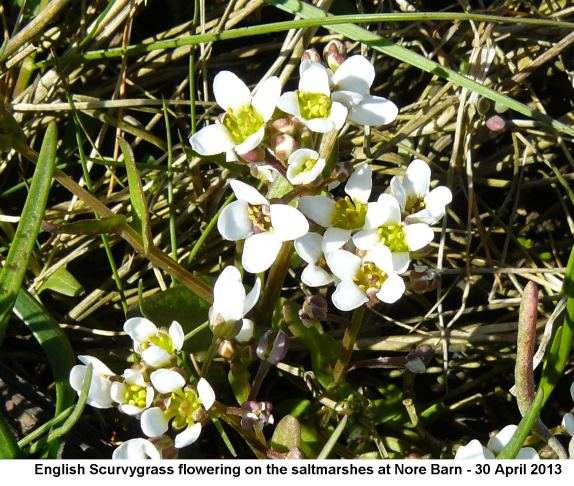
Described in The Hants
Flora as 'Locally frequent' ie in the right habitat.
From New Atlas: A biennial to perennial herb found in
saltmarshes on soft, silty substrates, and in firmer
areas of mud (and on sea-walls) near the high water
mark of estuaries and tidal rivers. Unlike C.
officinalis and C. danica, it is not found by roads.
Lowland. Native (change +0.02). The distribution of C.
anglica appears to be stable.
Lords
and Ladies
I usually look in Nore
Barn Woods for the first open spathes of Lords and
Ladies and there were several there today with spadix
showing well. However, as with most flowers it is late
this year. Last year I recorded it here on Mar 23.

From New Atlas: A
rhizomatous perennial herb of woodlands, hedgerows and
other shaded areas on moist, well-drained and
reasonably fertile soils. Generally lowland, Native
(change -0.28). The distribution of A. maculatum shows
little change since the 1962 Atlas. There has
undoubtedly been some loss caused by hedgerow removal
but this has been compensated for by its ability to
establish itself quickly in new areas of suitable
habitat such as scrub and plantations.
NORTH
HAYLING
11:30 - 12:30 - I went
over to check on the Black-tailed Godwits in 'Texaco
Bay', but the tide was too low when I arrived so I
went down the Hayling Billy Line and had a nostalgic
walk through the main Oysterbeds site. I was a
volunteer warden here for five years until 2008, doing
a weekly 3 hour stint and got to know the site and its
wildlife very well.
Little
Tern nesting site
I was interested to
see the new Little Tern nesting site described by
Chris Cockburn in yesterday's blog. This is an
'island' that Chris calls the 'North Spit' and is
situated north east of the saline lagoon and where the
crushed cockleshells were placed during the work
described by Chris. This was the site that Jason Crook
originally organised as an alternative nesting site
for the terns a several years ago when the
Black-headed Gulls first took over the main islands in
the lagoon. However, it was never used by the terns
despite the presence of tern decoys, four of which are
now in place on the current site. Let's hope for
better luck this time, but I am not overly optimistic.

Great
Gull show
Moving round the
corner to the lagoon I was immediately aware of the
raucous cries of hundreds of Black-headed Gulls that
are now nesting on the two islands in the lagoon -
islands we used to call 'tern islands'. I recall well
seeing Little Terns and Common Terns regularly nesting
on the islands, but, sadly, no longer. It is the
Black-headed Gull show now. I could certainly hear
Common Terns calling, but I could not see any on the
islands, though I only had my binoculars with me. I
see a pair of Oystercatchers have clung on, but I
don't know if they nest here any more. A male Gadwall
was an unusual bird to see in the lagoon. It was nice
to see a group of school children taking notes and
doing drawings of the gull islands.
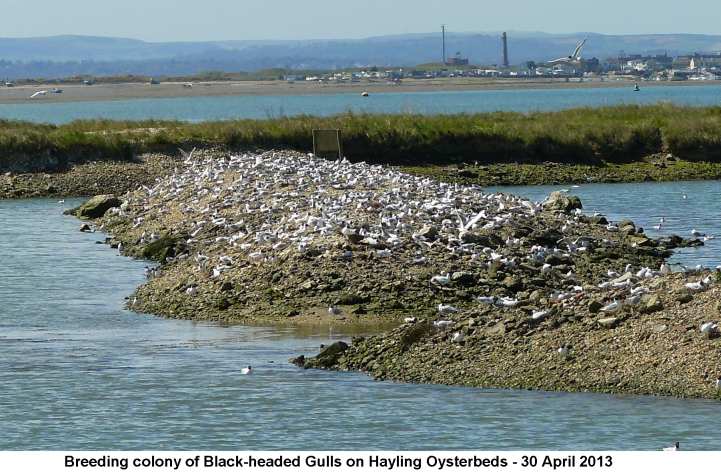
Plants
Forget-me-nots
were in flower on the mound behind the bus shelter. I
recall Ralph Hollins and others puzzling over these
plants as possible Early Forget-me-nots, but I think
their verdict was Field Forget-me-not. Glaucous
Sedge is now flowering on the edge of the Hayling
Billy Line along with my first Bulbous Buttercup.

Black-tailed
Godwits
By the time I got back
to 'Texaco Bay' at about 12.30, a flock of 51
Black-tailed Godwits along with 14 Common Redshanks
were feeding in shallow water. This was far fewer than
I expected from reports of over 200, so maybe they are
moving off. I went through them, but only found one
colour-ringed bird which I think was W+YG,
though the white ring was dirty and could possibly
have been lime. My last record of W+YG was at
Broadmarsh on 04-Aug-99. Could it possibly be the same
bird? That would make it at least 14 years old.

I could also see many
examples of 'spurting' behaviour and managed to
catch one on camera. Mike Wells also had a photo of
one yesterday.
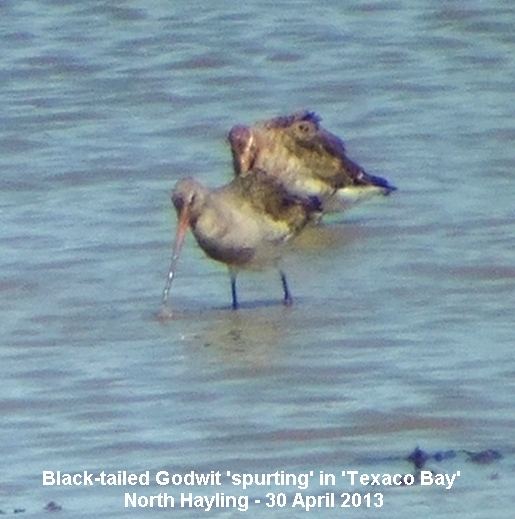
A Whimbrel was
feeding on the near shore.
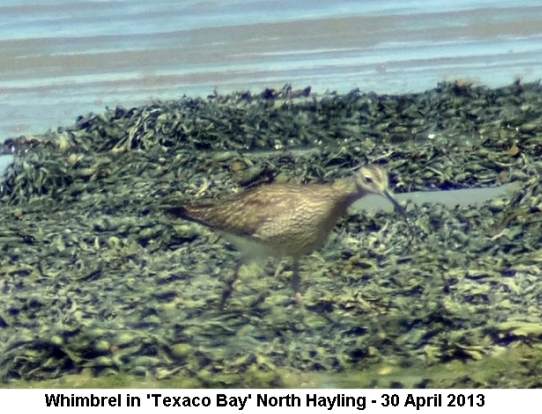
MILLPOND
NEWS
13:00 - On Slipper
Millpond the pair of Great Black-backed Gulls
were on the centre raft with one bird sitting on the
nest. The two Coot chicks were still in the nest box
on the north raft, so no more raids since yesterday.
When I arrived at
Peter Pond, the male Mute Swan (with normal
dark feet and legs) was standing over the nest on the
island; the female (with pink legs and feet) was in
the water nearby. I did not realise until now that
both male and female swans take turns in incubating
the eggs, though this is mostly done by the female.
Although I could see into the nest I could not see any
eggs, which I assume were covered. That is a good sign
that the birds are caring well for the eggs. The male
bird sat down on the nest while I was there and made
himself comfortable.

Mute
Swan 'litter nest'
Juliet Walker got a
nice image of the Mute Swan turning her 5 eggs in the
'litter nest' beneath the Havant Road bridge on the
town millpond yesterday. That is impressive! She is
really getting into it.

Juliet said the cob
was also present in the evening and was seeing off
ducks and also collecting sticks and litter to add to
the nest. But, she says, people tend to stand on the
bridge and lob bread over, which brings unwanted
attention to the nest, both from ducks and people.
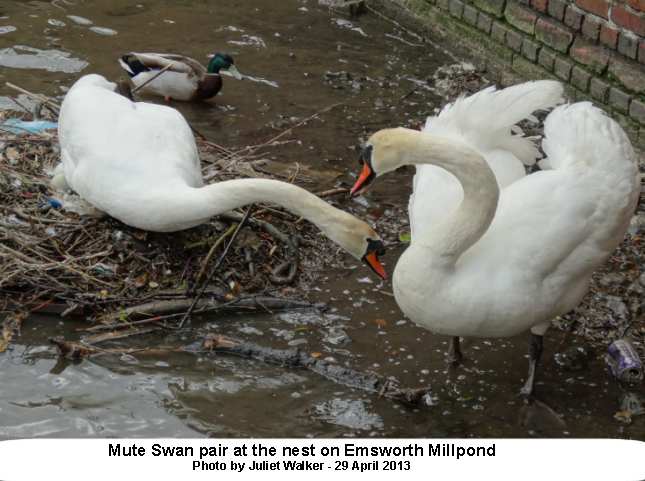
We all hope the swans
will be successful, but I am not optimistic. The pen
will need to stay sitting on her eggs for another 36
days (from the laying of the last egg) and look after
them carefully to make sure they reach maturity and
the cygnets hatch successfully. This is a hard task in
that situation. There have been several of these
'litter nests' on the millpond over the years (though
none in that particular site close to the bridge) and
none has been successful. But let's keep fingers
crossed for a miracle!
OTHER
NEWS
Butterflies
I had two reports of
Orange Tips today. Robin Pottinger had one in
his garden on Saturday Apr 27 and also saw one flying
on Brook Meadow today. Brian Lawrence saw one in
Hollybank Woods yesterday (Apr 29). So, they are out!
I also had my first Holly Blue of the year in
my garden, fluttering around the Ivy hedges.
Stock
Doves in garden
The two Stock Doves
were in my garden again this morning, feeding on the
lawn. This time I managed to get a photo of them
before they flew off. My previous sighting to two in
the garden was on April 28. Stock Doves have been very
rare birds in my garden until this year. The BTO does
not publish data for Stock Dove in the Garden
BirdWatch scheme, though I suspect the frequency is
fairly low in gardens.
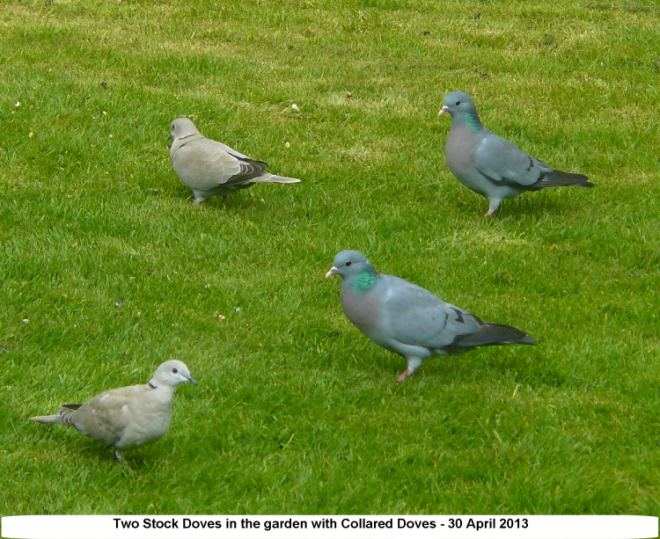
Barn
Owl in flight
Colin Vanner sent me
this superb photo of a Barn Owl he took at
Waterlooville today.

Brook
Meadow
Tony Wootton had a
couple of hours in the meadow this morning. He saw
Peacock, Comma, several small white ones, 2 male
Orange Tips and a Holly Blue. All the usual birds plus
Great Spotted Woodpecker and a kestrel. Best of all he
managed to photo a Whitethroat carrying nesting
material. That is good news.
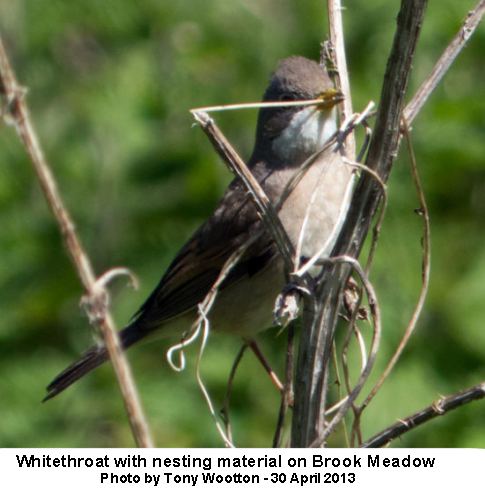
MONDAY
APRIL 29 - 2013
WAYSIDES
NEWS
Bramble
clearing
Jane Brook and I
continued our regular Monday morning surveys of the
Emsworth waysides. The weather was fine though with a
chill in the air. The main task this morning was to
clear the bramble spurs from the Bridge Road and the
A259 embankment waysides. This was tough and at time
painful work and we filled four bags with finely cut
brambles. But the work was well worth while as the
brambles were starting to encroach seriously on the
two waysides.
Wildlife
observations
On the Bridge Road
site we found the first Sweet Vernal Grass of the year
and also had the first Green-veined White feeding on
Dandelion flowers. On the A259 embankment Common
Whitlowgrass and Wavy Bitter-cress were growing at the
base of the Oak tree to the south of the main verge.
The
Green-veined White with heavily veined underwings
which is characteristic in the spring brood.

MILLPOND
NEWS
Mute
Swans
The Mute Swan was at
the 'litter nest' near the main road bride on the town
millpond with four eggs. The Mute Swan was off the
nest on Peter Pond and I could see three eggs in the
nest.
Great
Black-backed Gulls
The Great Black-backed
Gulls were both on the centre raft on Slipper
Millpond, with the female sitting on the nest. She
must be brooding eggs by now. With incubation 27-28
days hatching might be expected at around 26 May.
Coots
It looks as if the
Coot nest has been raided. The chicks on the north
raft were down to 2 from the brood of 6 seen on Apr
25. This loss of chicks was not unexpected with the
proximity of the Great Black-backed Gulls. Mind you,
the Coot parents were carrying on as if nothing had
happened. Birds don't have human emotions!
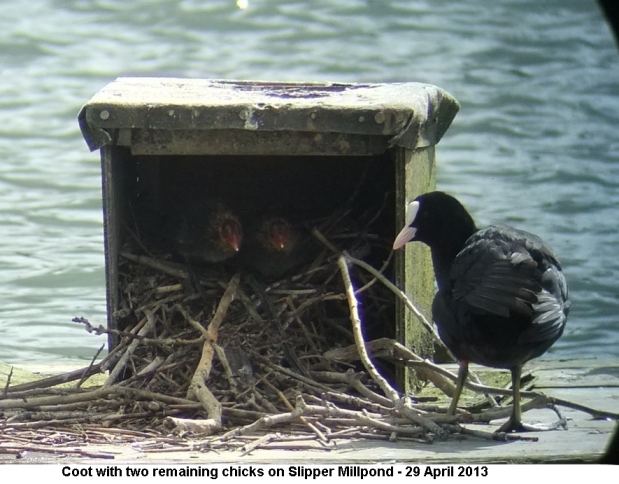
The Coot is still
sitting on a nest in the box on the south raft with no
chicks as yet. There is a new Coot nest in the reeds
to the east of the swan island on Peter Pond. This is
very near the water level and looks vulnerable.
GARDEN
NEWS
I had a pure white
dove in the garden again today. This is one of several
I see frequently around St James Church and probably
live in a local dovecot.
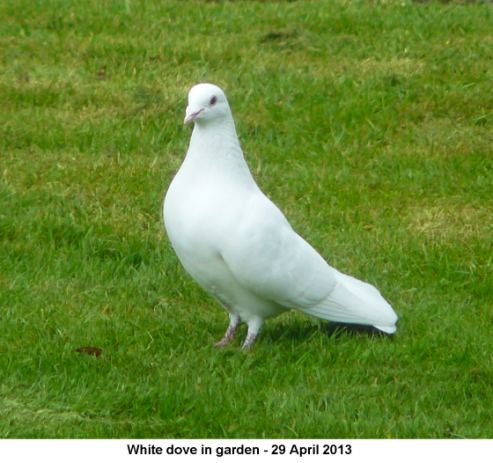
HAYLING
BILLY LINE
Mike Wells was in the
North Hayling Billy Line area today and sent me the
following photos. The first is a real cracker of a
Kestrel hovering against a clear blue sky. This
is probably the best one I have ever seen. From the
black tip to the tail and the spotted underparts I
would guess it was a male bird.
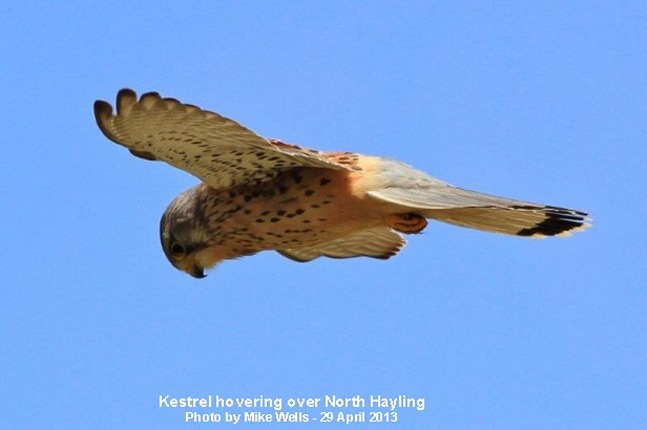
The other one is of a
group of Black-tailed Godwits, some in their
orange breeding plumage feeding in the 'Texaco Bay'
area. It is amazing how long these birds hang around
their wintering quarters. Don't they have a home to go
to? But of special interest to me is that one of the
Godwits is spurting water from its bill.
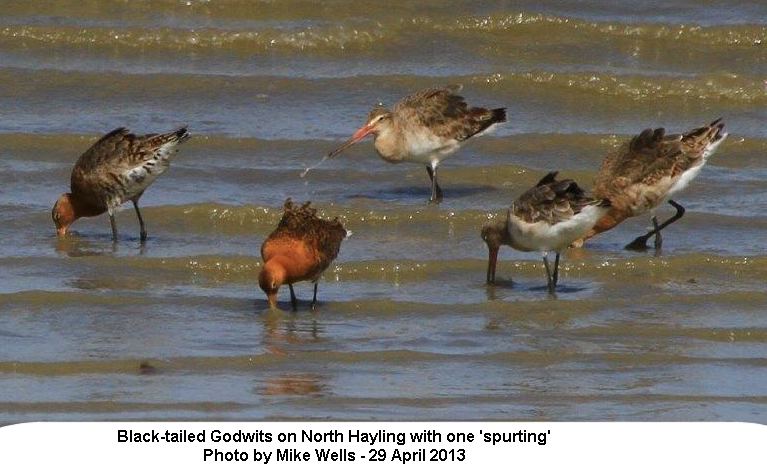
We have had lots of
examples of such 'spurting' behaviour from a variety
of waders, all of which have left the experts
scratching their heads. See the special web page for
more details and photos . . . . Spurting
behaviour
HAYLING
OYSTERBEDS WORK
Chris Cockburn wrote
to say that parts of Tom Bickerton's report on the
work taking place on Hayling Oysterbeds to help
nesting Little Terns (see entry for Friday April 26)
was slightly misleading. I am grateful to Chris for
the following summary to clarify things:
"Firstly, I am unsure
of the main source of funding for the Oysterbeds
works, but I think it might be from a Veolia grant and
not from Heritage Lottery Funding - it is very
important that the correct funding source is named.
The crushed
cockleshells will be used in a trial to try to improve
Little Tern nesting habitats on South Binness Island
and/or Baker's Island (most likely in time for the
2014 breeding season). Over time, wind, wave and tidal
action tends to remove fine material, leaving a very
stony surface layer that is not suitable for nesting
Little Terns. These birds look for relatively small
patches of fine material between larger 'lumps' of
shingle (the large lumps afford some protection from
the wind etc). In an earlier trial in 2010, 12
volumetric tonnes of uncrushed cockleshells were used,
but the little terns did not like them! A few bags of
crushed cockleshells were taken to the Hayling
Oysterbeds - not 8 volumetric tonnes.
A volunteer work party
from RSPB Pagham Harbour and one of the Oysterbeds'
RSPB volunteers cleared vegetation from the middle
third of the "North Spit", an 'island' situated north
east of the saline lagoon. The few bags of crushed
cockleshells were spread over part of the cleared area
and four Little Tern decoys were placed there. The
remaining cleared area has a surface of graded shingle
(a mixture of very fine and larger material). If
Little Terns do nest on "North Spit", it will be
instructive to note which habitat is preferred.
The western end of the
"Northwest Bund" (that is the bund that forms the
northern edge of the saline lagoon) was charged with
graded shingle (thus creating an ideal nesting
habitat); it will not be dressed with crushed
cockleshells. Similar operations using heavy machinery
on the harbour islands (2009) showed that the most
birds were not unsettled by the activities, the only
birds affected were those within a c50m radius. The
western end of the "Northwest Bund" is much further
than 50m from the nearest parts of the two islands in
the saline lagoon and it was seen that the nesting
black-headed gulls took no exception to the operations
and simply got on with nest-building, egg-brooding and
noisily asserted their territorial rights. Like the
crushed cockleshells, this shingle charging is a trial
and, if it proves successful, other parts of the
"Northwest Bund" may be charged in future years. The
new habitat is likely to be attractive to nesting
oystercatchers and ringed plovers. Secure fencing
during the breeding season will be necessary, but its
placement will need to be done by contractors having
experience and expertise in fencing on similar ground
conditions (rubble, chalk etc).
As far as I know,
there are no plans to set up a warden viewpoint "to
show the breeding activity of these birds for general
interested". The works at the Northwest Bund were
carried out by a local contractor - I am not aware of
how local companies helped and collaborated".
PS
Chris was told that
the edited filming will be broadcast on BBC
Countryfile on May 12.
Chris also points out
that Wez Smith's title is 'Sites Manager, Langstone
and Chichester Harbours, while his own badge states:
'RSPB Volunteer Warden Langstone Harbour'
SUNDAY
APRIL 28 - 2013
BROOK
MEADOW
This morning, I found
a number of plants in flower for the first time on
Brook Meadow, so spring is coming at last! All these
plants are 2-4 weeks later than usual.
There is a good growth
of Wintercress at the far end of the Seagull
Lane patch, in bud, but not yet in flower.
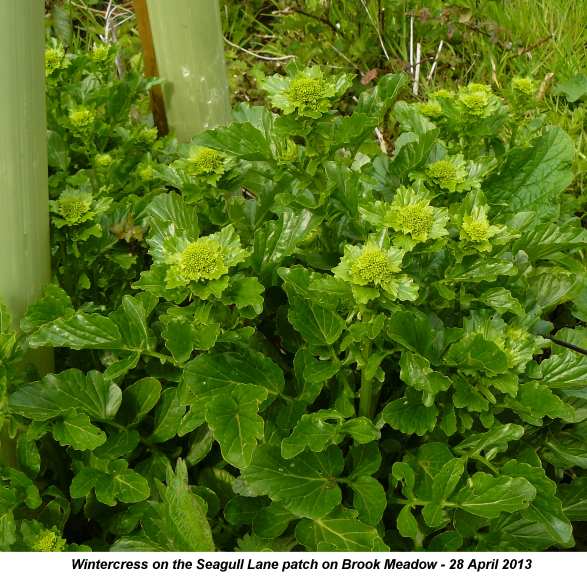
I am never sure
whether to call this simply Wintercress (Barbarea
vulgaris) or Early Wintercress (Barbarea
intermedia). The books say the one difference is
in the leaves; Wintercress has simple upper stem
leaves, whereas Early Wintercress has pinnately-lobed
upper stem leaves. The leaves were not fully developed
on the Brook Meadow plants, but the upper stems leaves
did appear to be simple and not pinnately lobed like
the lower stem leaves, which suggests they are
Wintercress (Barbarea vulgaris). I will need to check
them again when they have grown a bit.
I have checked
regularly for Ground-ivy flowers on the Seagull
Lane patch on Brook Meadow, but have not found any
until today when the first ones were open at the far
end of the patch.
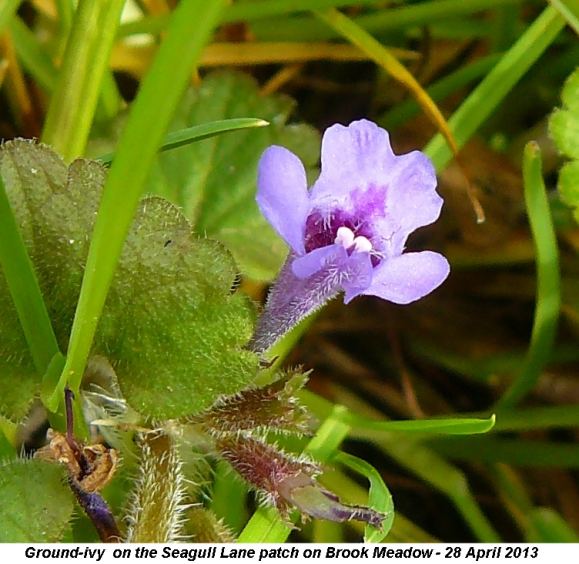
Garlic Mustard
was also out in this area. The first
Cuckooflower was out in the centre of the
orchid area on the north meadow. We never get many
Cuckooflowers on Brook Meadow in sharp contrast to the
Bridge Road Nature Reserve where I counted over 300
spikes on April 23. Finally, Distant Sedge and
Divided Sedge are starting to show spikelets on
an open area the eastern side of the Lumley area where
dead grasses are not lying.
Not on Brook Meadow,
but I also found my first flowering Greater
Celandine of the year in a neighbour's driveway in
Bridge Road.
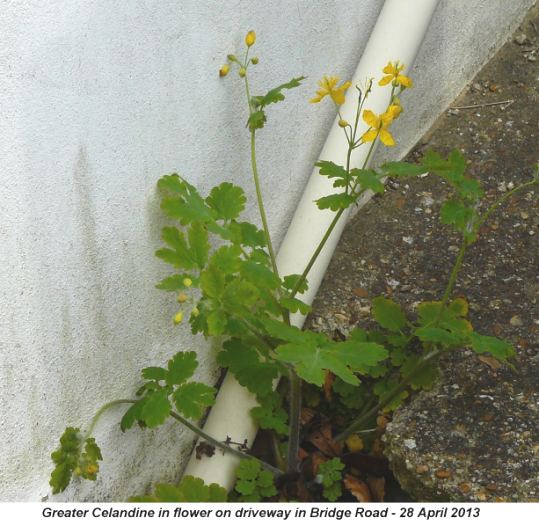
MUTE
SWAN NEWS
The Mute Swan was snug
on her nest on the island on Peter Pond when I passed
by this morning. She should have laid her first egg by
now, so we can start counting to the hatching date 36
days from now - Monday June 3rd.
Over on the town
millpond a swan is now sitting on the 'litter nest'
near the bridge which had four eggs in it yesterday.
We shall wait and see any developments, but I am not
at all optimistic of success.
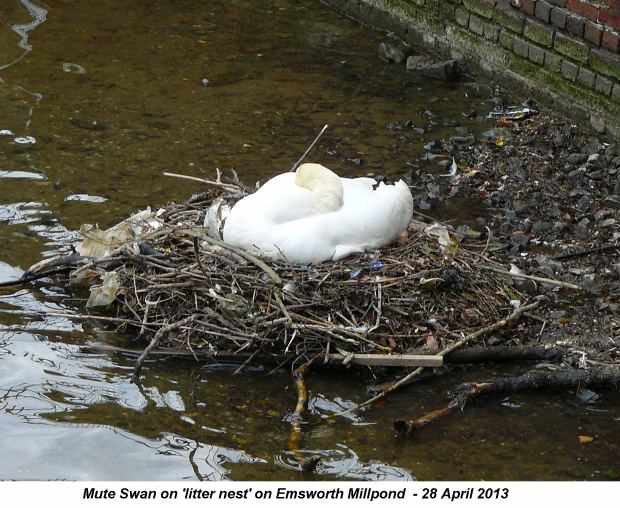
GARDEN
BIRDS
I had some unusual
visitors to the garden today. Two Stock Doves
were feeding on the seeds thrown onto the grass. I had
one Stock Dove in Mar of this year, but this was the
first time I have recorded two Stock Doves.
A little later a pair
of pure white doves were also on the grass.
These are from a dovecot somewhere close by; I often
see a small flock of these birds on St James Church.
These were the first I have seen in the garden since
Nov-Dec 2008. Unfortunately, I missed getting photos
of any of these visitors.
WARBLINGTON
WALK
Peter Milinets-Raby
took a walk along the Warblington shore this morning
(6:40am to 9am). The weather was too nice for
migrants. The tide was very low. The species of note
were:
10 Med Gulls feeding in the field next to Castle Farm
and a handsome cock Pheasant with them
6 to 10 Stock Doves (the 6 were feeding on the seed
that had been sown at the far end of the cemetery
extension - 'Wild Flower Patch').
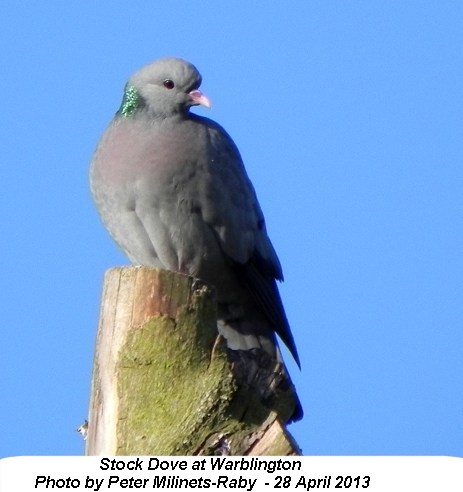
Yellow Wagtail over
heading north.
16 Grey Plover at Conigar Point (4 in stunning summer
plumage) - Also 13 Shelduck
3 Whimbrel and 4 Greenshank off Pook Lane - one with
coloured rings - RG, YY.
The pair of Gadwall (plus female Teal) were on the
small flood in the horse paddock adjacent to the
Langstone Mill Pond.
2 Reed Warblers singing from Langstone Mill Pond and
male Reed Bunting.
21 Little Egrets (This is probably an indication of
how many nests there are - it was eerily quiet with no
displaying, the birds present were 'sitting/loitering
with intent' - All the males were off fishing
somewhere - There were 7 feeding off Conigar
Point).
Carrion
Crow takes Goldfish
And, yesterday
Peter's wife watched a Carrion Crow take a 7
centimetre long Goldfish from the pond! The crow could
not hold it properly in its beak, dropped the fish on
the lawn. Peter's wife scared the crow off and rescued
the fish. This morning the fish was swimming around
the pond, quite unperturbed, but minus a dorsal
fin!
SATURDAY
APRIL 27 - 2013
Ashling
Wood
11:00 - I had to take
Jean and her sister over to Chichester this morning,
so I decided to check a few sites on the way home.
First stop was Ashling Wood where I found a very good
display of Bluebells with more to come. This is what
they were like on Mar 27 in 2012, so they are about 4
weeks later this year.

Marlpit
Lane
11:45 - My next stop
was Marlpit Lane. I parked the car about half way up
the lane between the amenity tip and the main
Funtington road. The first thing I heard when I got
out of the car was the incredible song of a
Nightingale from the bushes on the east of the
lane. It moved further up the lane and then stopped
singing. I waited for another 30 minutes without
hearing it again. During this time I was pleased to
meet David, a gardener from Bedhampton, who had also
heard the Nightingale singing.
Aldsworth
Pond
12:15 - I stopped
briefly to look over the pond from the roadside verge
though this is not easy with constant fast traffic on
the road. I could see lots of Swallows and House
Martins hunting over the pond. I wonder where they
all nest? Maybe in Sindles Farm? I could see a Canada
Goose sitting on a nest on the small island.
Hollybank
Woods
12:30 - I checked the
northern Bluebell area where there were a few more
flowers open than during last Sunday's 'Spring Walk',
but nowhere near as many as in Ashling Wood. I walked
down the main track to have a listen for the Garden
Warbler that Ralph Hollins thought he may have heard
singing from bushes east of the Holly Lodge clearing.
I heard no Garden Warbler, but I did hear no less than
five Blackcaps in the short walk, two of them around
the Holly Lodge clearing. Clearly, they are back!
BTO
reporting rates
The BTO confirm that
Blackcaps were about 2 weeks later than usual
. . . http://blx1.bto.org/bt-dailyresults/results/s412-21-13.html
However, Whitethroats were earlier which fitted
perfectly with my observations on Brook Meadow
http://blx1.bto.org/bt-dailyresults/results/s410-21-13.html
MILLPOND
NEWS
Mute
Swan nest
The Mute Swan was
sitting snugly on the nest on the Peter Pond island
when I arrived at about 5.30pm. The nest looked
reasonably well constructed and the pen was adding a
few twigs.
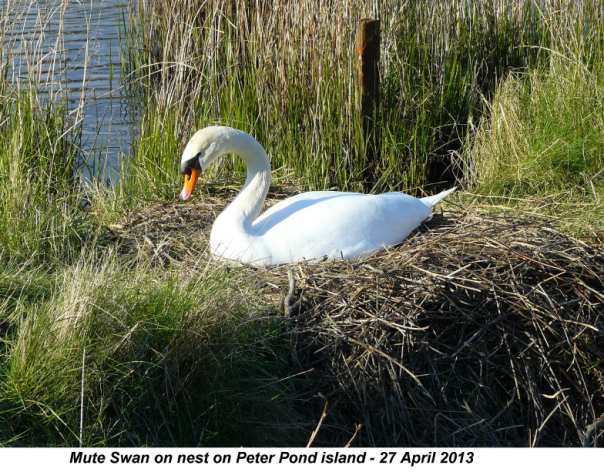
She stood up while I
was there which enabled me to confirm two things:
there were no eggs in the nest and the swan was the
'Polish' variety with pink legs. She could have been
one of a brood containing two other 'Polish' cygnets
that were born on the pond about 6 years ago. So, it
will be interesting to see the colour of the cygnets
when, and if, they get born. 'Polish' cygnets are all
white whereas normal cygnets are brown.
Slipper
Millpond nests
The Great
Black-backed Gulls were both on the centre raft on
Slipper Millpond with the female sitting on the nest.
I could just see the Coot chicks in the nest
box, so I assume they have survived so far. The Coot
nest on the western side of Slipper Millpond near the
path has been swamped by the tide.
Mute
Swan 'litter nest'
I was surprised to see
the 'litter nest' on the town millpond by the bridge
with four eggs in it and a Mute Swan in attendance
nearby. The nest was made mainly from twigs with
pieces of litter added and was just above the level of
the water. I gather someone asked the Environment
Agency to adjust the sluice gate so that the water in
the millpond remains below the level of the nest. The
eggs were covered by a piece of transparent plastic
which presumably the swan had put in place. Frankly, I
am not optimistic about this nest as the swan will
need to brood the eggs for 36 days before hatching and
I cannot see that happening. There have been other
'litter nests' on the millpond before which came to
nothing, but you never know.
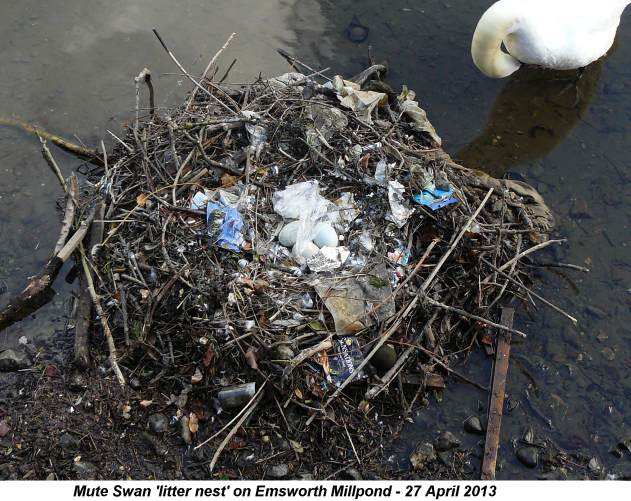
WAYSIDES
NEWS
Bluebells
(native?)
I found some Bluebells
in flower on the Lillywhite's path wayside which
looked as if they could be native ones. The flowers
were one-sided and drooping not erect as they would be
in the Spanish variety. However, I gather there are
many hybrid forms which escape and these could be one
of those. I recall querying this plant last year also.
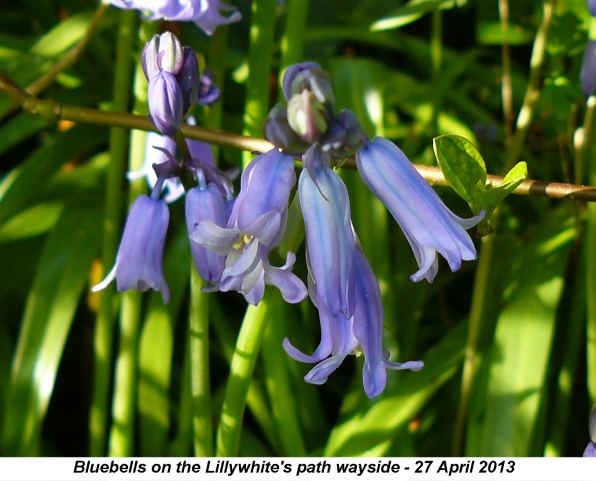
Basford
Willow catkins
The long yellow
catkins of the Basford Willow trees are now cascading
down onto the ground on the southern side of Palmer's
Road Car Park.
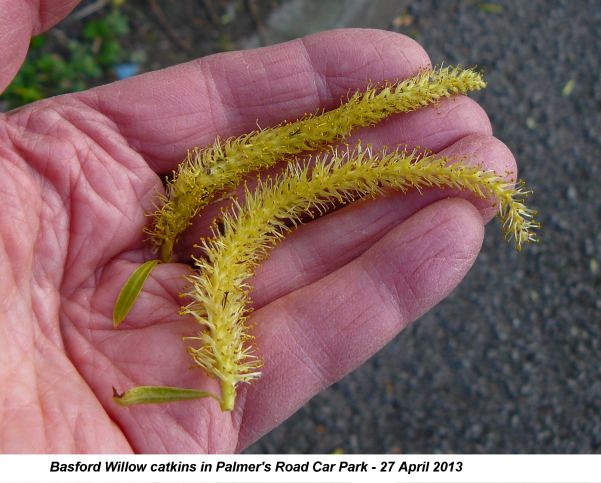
FRIDAY
APRIL 26 - 2013
MILLPOND
NEWS
Mute
Swans
The female Mute Swan
was off the nest on the Peter Pond island and was
pootling around on the water. The nest still looks a
bit flimsy and there were no visible eggs. The male of
the pair was on Slipper Millpond, no doubt defending
its territory from all comers.
Great
Black-backed Gulls
The pair of Great
Black-backed Gulls were both on the centre raft on
Slipper Millpond this morning, one bird (female) was
sitting on a nest while the other (male) did some
repairs to the nest.
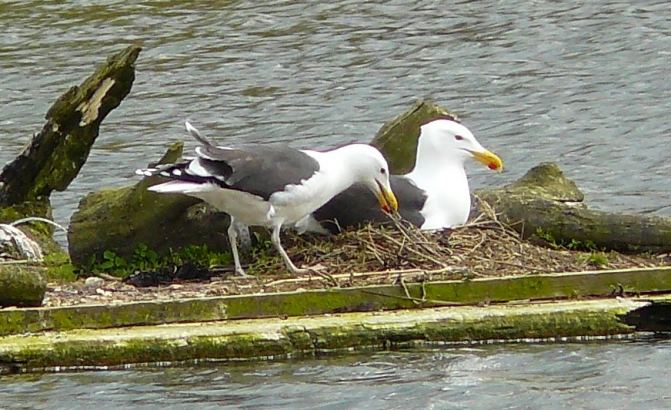
Coots
The Coot pair nesting
on the north raft were attending to the demands of
their brood on Slipper Millpond. I could only
definitely see five chicks, but the other may have
been hidden. I noticed another pair of Coot building a
nest in the reeds on the west of the pond just south
of the Chequers Quay estate. This is the third pair of
Coot on Slipper Millpond. There appear to be another
two pairs on Dolphin Lake, but I have no idea where
they are nesting. Meanwhile, there are two more Coot
pairs on Peter Pond, making a total of seven pairs in
all.
Reedbeds
There is still no
sound of either Reed Warbler or Sedge Warbler from the
reedbeds to the north of Peter Pond. The Sedge Warbler
that Peter Milinets-Raby heard on Apr 19 was probably
just moving through.
LUMLEY
AREA
Blackcaps
I heard several
Blackcaps in the area in the Brook Meadow - Lumley
area this morning, including the first one in Palmer's
Road Copse by the south bridge. So, it looks as if
they are back.
Greater
Celandine
Three Greater
Celandine plants are now showing well near Lumley Mill
at the end of the footpath from Seagull Lane.
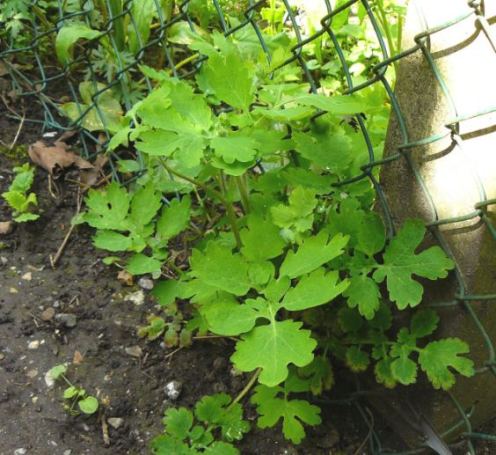
I look forward to
seeing the yellow poppy-like flowers in the near
future. This is the only place that I am aware of that
they grow in the local area. Greater Celandine is not
related to Lesser Celandine. It is said to be
poisonous, though I cannot really imagine anyone
wanting to eat it.
Sluice
gates
The new metal sluice
gates at Constant Springs are a big improvement over
the old wooden gates. They were installed by the
Environment Agency, though it seems as if the
residents of Constant Springs still have control over
them - there is a gate through to the sluice from the
garden. The gates were open this morning when I looked
with the water rushing down into the Lumley Stream.

MARLPIT
LANE
I checked Marlpit Lane
this evening at around 8pm to 8.30pm, but failed to
hear any hint of a Nightingale song. I have only two
records of Nightingale singing at Marlpit Lane this
year. The first by Barry Collins on Apr 17 and the
other by James Collings-Wells on the morning of Apr
21. I would appreciate reports from other people
visiting the site, positive or negative.
COUNTRYFILE
VISITS HAYLING OYSTERBEDS
A
report by Tom Bickerton
Thursday 25th
April - The BBC Countryfile came down to report
and film on the re-creation of suitable breeding habit
for Little Terns within Langstone Harbour. The crew
started filming at 8:00am at The Broadmarsh Coastal
Park where 8 tonnes of cockleshells where crushed and
bagged. They then moved on to Hayling Oysterbeds where
volunteers had cleared vegetation from one of the
islands, the crushed shell where then evenly spread
over the area. On hand for advice were Wez Smith (RSPB
Langstone Harbour Warden) and Chris Cockburn,
(volunteer for the Oysterbeds). They both detailed the
intentions for the Oysterbeds regarding Little Terns.
Four decoy Little Tern models were placed down to
entice the terns to use the island for breeding.
Friday 26th
April - A barge and excavator were in position
close to the south side to off-load 100 Tonnes of
graded shingle onto the outer bung of Oysterbeds
today; this again will be dressed with the crushed
cockleshell. The Terns have shown in the past an
interest for this particular area of the site and it
is hoped that this new raised area will now tempt then
to attempt breeding.If the birds do breed then the
area will have to be secured from human and predator's
activity and a warden viewpoint set up to show the
breeding activity of these birds for general
interested. It may also be that, because of this new
secured area, Ringed Plover may again start to breed
and it may now be possible to place a nest box for
Shelduck. None of this would have been possible
without the obtaining of a lottery grant and the help
and collaboration of local companies.
The report should go
out on the BBC Countryfile Show in early
May.
My note: What
were the resident Black-headed Gulls doing while all
this activity was going on on the islands?
LANGSTONE
MILL POND
Peter Milinets-Raby
walked to Langstone Mill Pond with his young son this
morning from 10:30am to just after mid-day. Birds of
note included the following:
Yellow Wagtail over
heading north
2 Buzzard
Green Woodpecker
6+ Chiffchaff
2 Whitethroat moving through the bushes
2 Reed Warblers singing
Reed Bunting singing
13 Shelduck
Whimbrel
Greenshank
32 Bar-tailed Godwit
2 Swallow
3 Sandwich Tern
4 Grey Herons
Purple Heron ? - flying over, but it was below the
horizon before Peter could get his binoculars on it.
He heard one was seen going over Portsdown Hill at
1:30pm, so it could have been!
54+ Little Egrets - At least 13 pairs, but still too
early to count. Looks like being a bumper year for
them! - See Ralph Hollins count below.
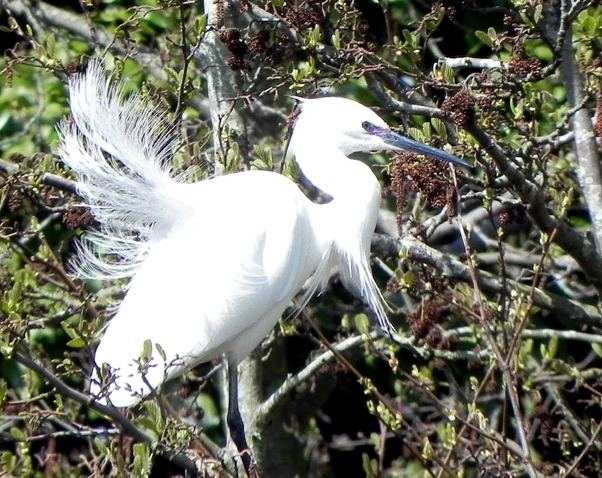
Langstone
Little Egret roost
Ralph Hollins checked
the Little Egret roost on Thursday April 25 at around
19:30 (sunset at 20:15) and counted 58 which he was
pretty sure was an under-count. Ralph counted more as
they arrived and reached 89 birds but as it was still
light when he left there were more were still to come
in. See . . . http://ralph-hollins.net/Diary.htm
BAFFINS
POND
Eric Eddles had a
puzzle today on Baffins Pond when he saw what looked
like a pair of Gadwall were on the pond. However, on
closer inspection the female Gadwall turned out to be
a Mallard. Gadwall and Mallard females are not easy to
tell apart, though fortunately the Gadwall are usually
in male-female pairs. One can just see the tell-tale
dark blue speculum on the female in Eddie's photo
indicating a Mallard. Gadwall would have a white
speculum. I have never seen a Gadwall - Mallard pair
like Eddie had. I wonder if they will breed?
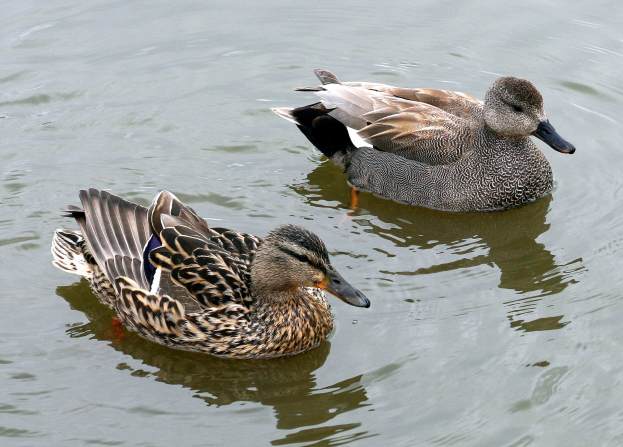
For
earlier observations go to . . April
16-30